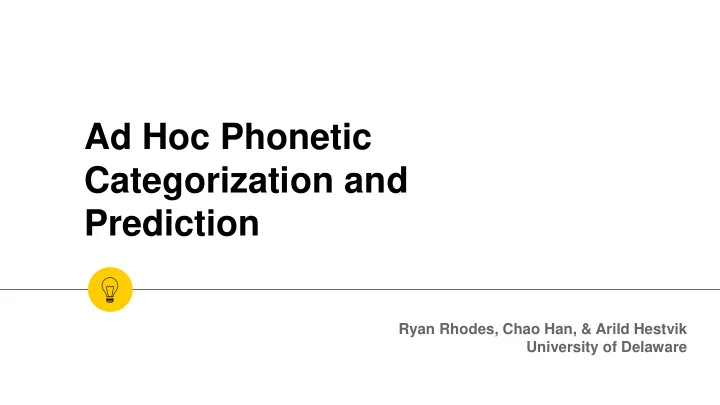

Ad Hoc Phonetic Categorization and Prediction Ryan Rhodes, Chao Han, & Arild Hestvik University of Delaware
Levels of perception Acoustic Sensory ◉ Phonetic Intermediate ◉ Phonemic Conceptual ◉ 2 Pierrehumbert (1990); Werker and Logan (1985)
Predictive coding Model is used to make sensory prediction Prediction in the auditory system: ◉ Predictions are encoded neuronally. ○ Predictions are hierarchically ○ organized. Different information is encoded at ○ Sensory Input is used to different hierarchical levels. update the model ◉ Goal of the system : reduce prediction error. 3 Friston (2005, 2010); Heilbron and Chait (2018)
◉ Neural signature of prediction error: ○ Mismatch Negativity (MMN) ○ Frequent repeated standard(s) ○ Infrequent deviant Näätänen, Gaillard, & Mäntysalo (1978), Näätänen (1992); Näätänen, Paavilainen, Rinne, & Alho (2007) 4
Experiment 1 – Across-category contrast Participants : 37 undergrads at the University of Delaware Stimuli : Klatt-synthesized [dæ] and [tæ] syllables, sampled from VOT continuum ○ 290ms ○ 65dB Blocks : High, Low ○ Low: 60, 65, 70ms VOT ○ High: 75, 80, 85ms VOT
Experiment 1 – Across-category contrast ◉ Phonemic level prediction: Low Condition High Condition ○ Equivalent prediction error (MMN) in both conditions. Phonemic t t t d t t t d Phonetic 60 70 65 15 80 75 85 15 ◉ Phonetic level prediction: ○ Greater magnitude prediction error (MMN) with greater phonetic distance.
Low Condition Results No difference between conditions. * * p < 0.05 High Condition Phonemic prediction – no phonetic prediction. * 7
Experiment 2 – Within-category contrast Participants : 27 undergrads at the University of Delaware Stimuli : modified stimuli from Exp 1 – all VOT values increased by 35ms Blocks : High, Low ○ Low: 95, 100, 105ms VOT ○ High: 110, 115, 120ms VOT
Experiment 2 – Within-category contrast ◉ Phonemic level Low Condition High Condition prediction: ○ Phonemic t t t t t t t t No prediction error (MMN) in either condition. Phonetic 95 105 100 50 115 110 120 50 ◉ Phonetic level prediction: ○ Prediction error (MMN) in both conditions. ○ Greater magnitude prediction error (MMN) with greater phonetic distance.
Low Condition Results - EEG Mismatch in both conditions. No difference between * * p < 0.05 conditions. High Condition 10 *
Results - Categorization ◉ VOT categorization pre- and post-test ◉ Threshold analysis for each participant Identification Task Session 1 Session 2 N 26 26 Mean 52.7 54.6 Median 51.3 51.7 Standard deviation 13.5 15.9 Minimum 33.4 32.5 Maximum 76.5 99.8 Shapiro-Wilk p 0.139 0.081 11
Results - Correlation ◉ Significant negative correlation between voicing threshold and MMN. ○ Higher threshold > more negative MMN response ○ Participants who categorize the 50ms VOT stimulus as /d/ are much more likely to have an MMN than participants who categorize all stimuli as /t/ . 12
Discussion Experiment 1 Experiment 2 ◉ ◉ ○ ○ MMN to across-category MMN to within-category contrast contrast ○ ○ No effect of phonetic No effect of phonetic distance distance ○ MMN correlates with perceptual threshold ■ Contrast is not within- category for all subjects! Phonemic (but not ◉ phonetic) prediction. Phonemic (but not ◉ 13 phonetic) prediction.
Conclusion In response to phonetically-varying input – the ◉ auditory system does not make phonetically- detailed predictions. Predictions are only maintained at the category ○ level. 14
Thanks to my collaborators Chao Han Arild Hestvik Lena Herman 15
Recommend
More recommend